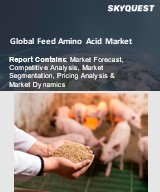
Report ID: SQMIG15E2437

Report ID:
SQMIG15E2437 |
Region:
Global |
Published Date: July, 2001
Pages:
247
|
Tables:
67 |
Figures:
75
Feed Amino Acid Market size was valued at USD 7.01 billion in 2019 and is poised to grow from USD 7.4 billion in 2023 to USD 11.97 billion by 2031, growing at a CAGR of 5.5% in the forecast period (2024-2031).
Proteins and amino acids are essential components in the growth and maintenance of animals. Animals like calves, broilers, and pigs depend on amino acids as a source of nourishment as well as an increase in their metabolic rate. There are 21 different types of essential amino acids found in animal bodies. These amino acids cannot be directly produced by the organism. Amino acids found in animal feed are a type of protein that, in addition to supplying energy, contains a variety of other nutrients, including vitamins, minerals, fats, oils, and carbs. Thereby provide animal feed growth, development, lactation, health and reproduction, and enhanced metabolism rate. The feed amino acid finds its use in the swine, ruminants, poultry, aquatics, and equine applications.
US Feed Amino Acid Market is poised to grow at a sustainable CAGR for the next forecast year.
Our industry expert will work with you to provide you with customized data in a short amount of time.
REQUEST FREE CUSTOMIZATIONWant to customize this report? This report can be personalized according to your needs. Our analysts and industry experts will work directly with you to understand your requirements and provide you with customized data in a short amount of time. We offer $1000 worth of FREE customization at the time of purchase.

Report ID: SQMIG15E2437